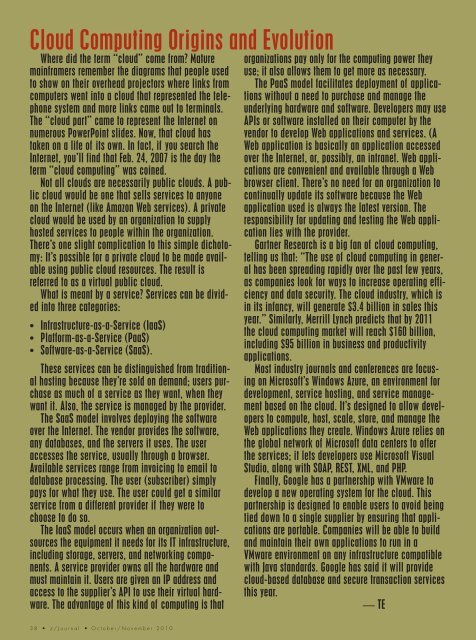z/VSE: 45 Years of Progress - z/VM - IBM
z/VSE: 45 Years of Progress - z/VM - IBM
z/VSE: 45 Years of Progress - z/VM - IBM
You also want an ePaper? Increase the reach of your titles
YUMPU automatically turns print PDFs into web optimized ePapers that Google loves.
Cloud Computing Origins and Evolution<br />
Where did the term “cloud” come from? Mature<br />
mainframers remember the diagrams that people used<br />
to show on their overhead projectors where links from<br />
computers went into a cloud that represented the telephone<br />
system and more links came out to terminals.<br />
The “cloud part” came to represent the Internet on<br />
numerous PowerPoint slides. Now, that cloud has<br />
taken on a life <strong>of</strong> its own. In fact, if you search the<br />
Internet, you’ll find that Feb. 24, 2007 is the day the<br />
term “cloud computing” was coined.<br />
Not all clouds are necessarily public clouds. A public<br />
cloud would be one that sells services to anyone<br />
on the Internet (like Amazon Web services). A private<br />
cloud would be used by an organization to supply<br />
hosted services to people within the organization.<br />
There’s one slight complication to this simple dichotomy:<br />
It’s possible for a private cloud to be made available<br />
using public cloud resources. The result is<br />
referred to as a virtual public cloud.<br />
What is meant by a service? Services can be divided<br />
into three categories:<br />
• Infrastructure-as-a-Service (IaaS)<br />
• Platform-as-a-Service (PaaS)<br />
• S<strong>of</strong>tware-as-a-Service (SaaS).<br />
These services can be distinguished from traditional<br />
hosting because they’re sold on demand; users purchase<br />
as much <strong>of</strong> a service as they want, when they<br />
want it. Also, the service is managed by the provider.<br />
The SaaS model involves deploying the s<strong>of</strong>tware<br />
over the Internet. The vendor provides the s<strong>of</strong>tware,<br />
any databases, and the servers it uses. The user<br />
accesses the service, usually through a browser.<br />
Available services range from invoicing to email to<br />
database processing. The user (subscriber) simply<br />
pays for what they use. The user could get a similar<br />
service from a different provider if they were to<br />
choose to do so.<br />
The IaaS model occurs when an organization outsources<br />
the equipment it needs for its IT infrastructure,<br />
including storage, servers, and networking components.<br />
A service provider owns all the hardware and<br />
must maintain it. Users are given an IP address and<br />
access to the supplier’s API to use their virtual hardware.<br />
The advantage <strong>of</strong> this kind <strong>of</strong> computing is that<br />
organizations pay only for the computing power they<br />
use; it also allows them to get more as necessary.<br />
The PaaS model facilitates deployment <strong>of</strong> applications<br />
without a need to purchase and manage the<br />
underlying hardware and s<strong>of</strong>tware. Developers may use<br />
APIs or s<strong>of</strong>tware installed on their computer by the<br />
vendor to develop Web applications and services. (A<br />
Web application is basically an application accessed<br />
over the Internet, or, possibly, an intranet. Web applications<br />
are convenient and available through a Web<br />
browser client. There’s no need for an organization to<br />
continually update its s<strong>of</strong>tware because the Web<br />
application used is always the latest version. The<br />
responsibility for updating and testing the Web application<br />
lies with the provider.<br />
Gartner Research is a big fan <strong>of</strong> cloud computing,<br />
telling us that: “The use <strong>of</strong> cloud computing in general<br />
has been spreading rapidly over the past few years,<br />
as companies look for ways to increase operating efficiency<br />
and data security. The cloud industry, which is<br />
in its infancy, will generate $3.4 billion in sales this<br />
year.” Similarly, Merrill Lynch predicts that by 2011<br />
the cloud computing market will reach $160 billion,<br />
including $95 billion in business and productivity<br />
applications.<br />
Most industry journals and conferences are focusing<br />
on Micros<strong>of</strong>t’s Windows Azure, an environment for<br />
development, service hosting, and service management<br />
based on the cloud. It’s designed to allow developers<br />
to compute, host, scale, store, and manage the<br />
Web applications they create. Windows Azure relies on<br />
the global network <strong>of</strong> Micros<strong>of</strong>t data centers to <strong>of</strong>fer<br />
the services; it lets developers use Micros<strong>of</strong>t Visual<br />
Studio, along with SOAP, REST, XML, and PHP.<br />
Finally, Google has a partnership with <strong>VM</strong>ware to<br />
develop a new operating system for the cloud. This<br />
partnership is designed to enable users to avoid being<br />
tied down to a single supplier by ensuring that applications<br />
are portable. Companies will be able to build<br />
and maintain their own applications to run in a<br />
<strong>VM</strong>ware environment on any infrastructure compatible<br />
with Java standards. Google has said it will provide<br />
cloud-based database and secure transaction services<br />
this year.<br />
— TE<br />
3 8 • z / J o u r n a l • O c t o b e r / N o v e m b e r 2 0 1 0

















